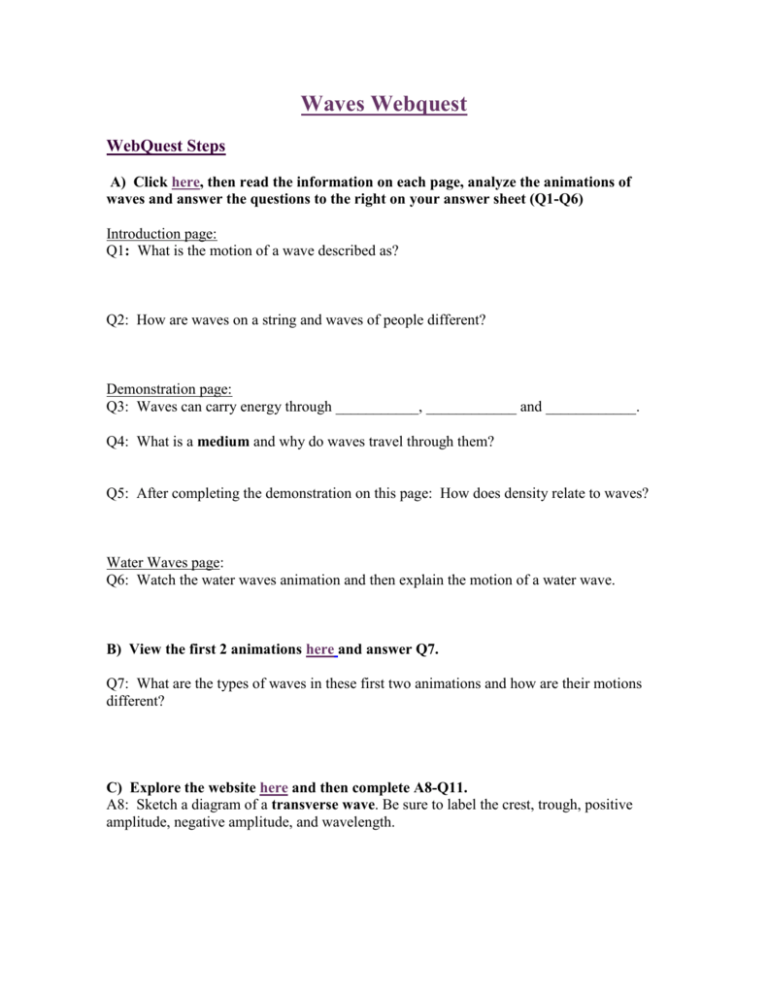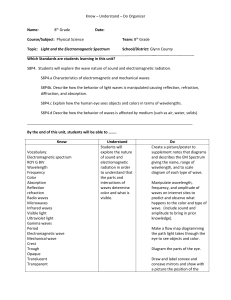Waves Webquest
advertisement

Waves Webquest WebQuest Steps A) Click here, then read the information on each page, analyze the animations of waves and answer the questions to the right on your answer sheet (Q1-Q6) Introduction page: Q1: What is the motion of a wave described as? Q2: How are waves on a string and waves of people different? Demonstration page: Q3: Waves can carry energy through ___________, ____________ and ____________. Q4: What is a medium and why do waves travel through them? Q5: After completing the demonstration on this page: How does density relate to waves? Water Waves page: Q6: Watch the water waves animation and then explain the motion of a water wave. B) View the first 2 animations here and answer Q7. Q7: What are the types of waves in these first two animations and how are their motions different? C) Explore the website here and then complete A8-Q11. A8: Sketch a diagram of a transverse wave. Be sure to label the crest, trough, positive amplitude, negative amplitude, and wavelength. Q9: What does the straight line in a transverse wave represent? Q10: What is frequency and what unit is it measured in? Q11: On the website, try adjusting the frequency on the animation. Then explain how frequency and wavelength are related. Topic Two: Electromagnetic Spectrum D) Read NASA's Introduction to the Electromagnetic Spectrum here and answer the questions. Q12: How does Electromagnetic Energy Travel? Q13: What is the Electromagnetic Spectrum? Q14: What is the source of energy across the entire Spectrum? Q15: Why and how does our atmosphere protect us from the Spectrum? E) Visit here and answer the questions. Q16: How are Electromagnetic waves different from all other waves (mechanical waves)? (Hint: there is something they do not need) Q17: After looking at the diagrams on this page, Electromagnetic waves are formed by the vibrations of _____________ and _____________ fields. F) Go to the page here and complete A18. A18: Complete the chart for the different behaviors of waves. Write down ALL important information for each behavior. See my example for reflection. Type of Behavior Description of Behavior Reflection Absorption Diffraction Scatter Refraction -When light hits an object and bounces off -Smoother surfaces reflect more -color is actually waves of light reflected G) Go to this NASA page here on radio waves. Then click on each of the pages below the Radio Waves page (on the right bar of the website) as you complete A19. A19: Complete the chart by filling out the information for each type of wave. Type of EM Wave Radio Micro Infrared Visible Light Frequency Description Examples (More than 1!) Type of EM Wave Frequency Description Ultra Violet (UV) X-rays Gamma Rays Q20: After going here, describe the Earth's Energy Budget. Examples (More than 1!)








